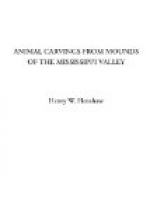Noticing that one of the carvings has a differently shaped tail from the others, the authors of the “Ancient Monuments” attempt to reconcile the discrepancy as follows: “Only one of the sculptures exhibits a flat truncated tail; the others are round. There is however a variety of the lamantin (Manitus Senigalensis, Desm.) which has a round tail, and is distinguished as the “round-tailed manitus.” (Ancient Monuments, p. 252.) The suggestion thus thrown out means, if it means anything, that the sculpture exhibiting a flat tail is the only one referable to the manatee of Florida and southward, the M. Americanus, while those with round tails are to be identified with the so-called “Round-tailed Lamantin,” the M. Senegalensis, which lives in the rivers of Senegambia and along the coast of Western Africa. It is to be regretted that the above authors did not go further and explain the manner in which they suppose the Mound-Builders became acquainted with an animal inhabiting the West African coast. Elastic as has proved to be the thread upon which hangs the migration theory, it would seem to be hardly capable of bearing the strain required for it to reach from the Mississippi Valley to Africa.
Had the authors been better acquainted with the anatomy of the manatees the above suggestion would never have been made, since the tails of the two forms are, so far as known, almost exactly alike. A rounded tail is, in fact, the first requisite of the genus Manatus, to which both the manatees alluded to belong, in distinction from the forked tail of the genus Halicore.
Whether the tails of the sculptured manatees be round or flat matters little, however, since they bear no resemblance to manatee tails, either of the round or flat tailed varieties, or, for that matter, to tails of any sort. In many of the animal carvings the head alone engaged the sculptor’s attention, the body and members being omitted entirely, or else roughly blocked out; as, for instance, in the case of the squirrel given above, in which the hind parts are simply rounded off into convenient shape, with no attempt at their delineation. Somewhat the same method was evidently followed in the case of the supposed manatees, only after the pipe cavities had been excavated the block was shaped off in a manner




